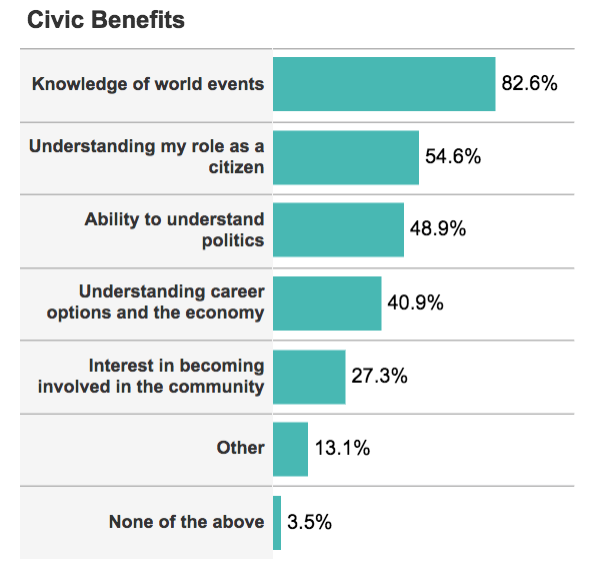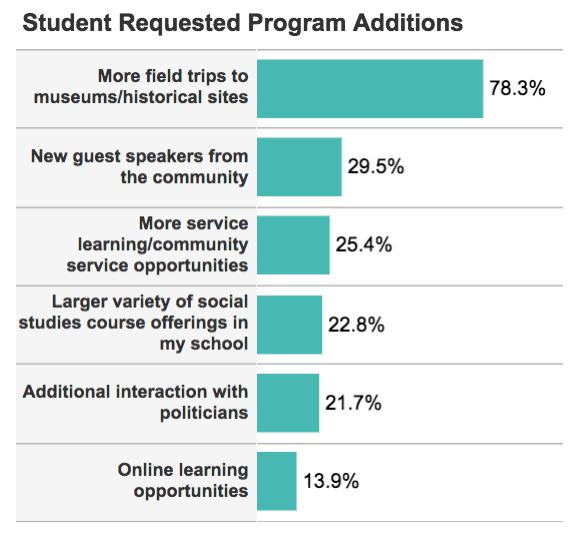Each year, National Council for the Social Studies (NCSS) participates in a nationwide survey for high school seniors and social studies teachers through My College Options. Included in this survey are several questions for students about their social studies school experience, and other questions for teachers about their social studies programs and general professional learning needs. I am starting to share our 2017-18 survey results, following up on my “State of Social Studies in 2017” presentations to Affiliated Councils and other groups last year. For our 2018 edition, I am pleased to announce that over 103,000 students and 1,400 educators nationwide shared feedback with us. Our student respondents are spread throughout each region of the country; our teachers are both NCSS members and non-members, so they represent a wide view of educators overall.
Surveys of social studies education’s impact provide vital information for all of us to better understand classrooms across the country. With the release of a new nationwide National Survey for the Civic Learning Systems Map (see our May 29, 2018 edition of The Social Studies Professional for a complete description), understanding of civic life and health in our nation’s schools are very important right now. Those of us in the education profession know how valuable civic learning is to the social studies, and to a well-rounded education in general. Every day, educators share stories from their students about how civic engagement, and learning about civic roles and responsibilities, are so important to their own paths and pursuits. Look no further than our news feeds for students actively engaging in public discourse, describing interests in holding public office, and tackling massive challenges right now (not in the distant future). All of this is highly encouraging to me. Our social studies educators create the spaces that enable our students’ minds to flourish, and to think about the challenges and opportunities they want to address as informed citizens.
While educators often discuss the importance of civic learning in social studies and school, what does the general public know? From our survey last year, we learned that virtually every student gains some form of civic benefit from their social studies classes. Here’s a snapshot:

Yes, students could select more than one response, so the math adds up to more than 100%. Yet the fact that the vast majority of our students chose “knowledge of world events” as a civic benefit of social studies is very important in understanding why civic learning matters – and why campaigns like #CivXNow are vital in building awareness of more needed instructional resources and learning opportunities by our students and schools. Civic learning is knowing about the world; by knowing our world, we are informed and likely to be engaged as an active and productive member of society. This is good news for anyone who wonders whether “civics” or “social studies” in general really matters. They do! Our kids are telling us that they do.
Two pieces of data from the graphic above trouble me a bit; maybe you caught them, as well. Fifty-five percent of our respondents said that “understanding my role as a citizen” is a civic benefit of social studies; however, only 27% said that they have “interest in becoming involved in the community." This disparity in “I know what I need to do, but I’m not engaged to do it” provides an opportunity for us to expand the social studies experience throughout our instructional programs and out-of-school activities. The College, Career, and Civic Life (“C3”) Framework for State Social Studies Standards includes a dimension called Communicating Conclusions and Taking Informed Action. I have written about this dimension before, because I think it is fundamental in re-imagining what our social studies experience and outcomes look like when they focus on inquiry. Imagine if instruction concluded with students demonstrating thinking in collaborative ways, sharing and building on each other’s thinking. Maybe they map out and plan a way to solve a particular challenge. Perhaps they demonstrate their proposed solutions in an open forum, in or out of school. There are limitless possibilities – the key is students communicate and collaborate on the conclusions they draw. They share the results of their work with others, and develop a plan to take informed action based on those results. Even if they do not take action right away, they learn what action would be needed to address an issue. While there will probably always be a place for “traditional” end-of-unit tests and papers, I call such assessments “transactional between student and teacher” because they do not provide a chance for students to share and expand upon their conclusions with others. Much as the world does not function solely on “transactions” between individuals, but collaborations between teams, the C3 Framework’s fourth dimension makes the case that real engagement happens when students share and build conclusions together.
Of course, we need more civic learning in general: only 17% of our students reported taking a civics class, sandwiched between economics (19.4%) and psychology (10.7%) in frequency. The strength of the C3 Framework and its fourth dimension is that it applies to any discipline. Start by fostering collaborative discussions and conclusions in your state history or geography class, and you will see greater interest in students talking about historical or geographic issues as civic ones. This is how we start to see more students not just knowledgeable about civic life, but motivated to participate in it too!
One more piece of information to share: our students also have ideas on what to add in social studies classrooms to expand their civic learning. Take a look at the data below.

Each of these approaches can be implemented in any social studies classroom for increased civic benefit. For those of us in communities that do not have easily-accessible cultural institutions, see if your technology is strong enough to take students on virtual field trips. Bringing community members into school to describe their professional or volunteer work is always interesting because students can see and interact with people whose careers are shaped by civic engagement. Sending students out into the community for activities and learning is another way to enhance their civic life and experiences.
We are proud to support the work of iCivics and the Jonathan M. Tisch College of Civic Life at Tufts University in fostering a strong civic life for our students and schools through their survey. I hope you will take the survey, and also keep learning about what our students and educators love – and want – most from their social studies experiences. We know that civic learning matters. And we know social studies provides the civic benefits that our students ask for!